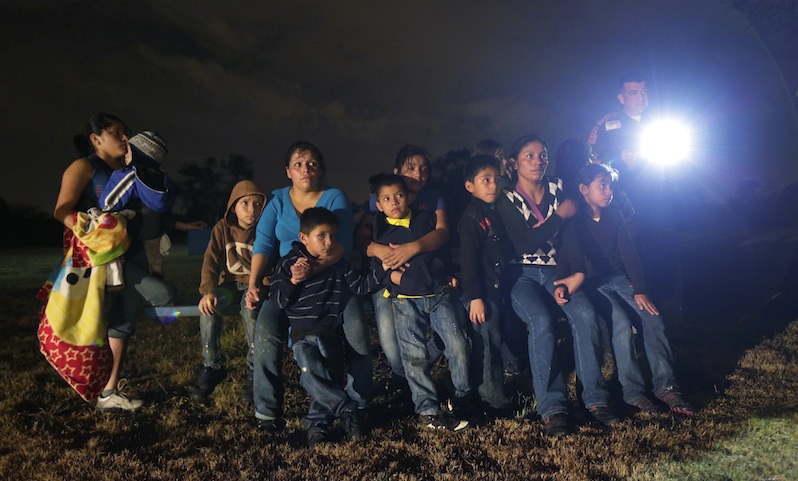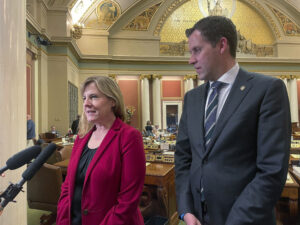Welcoming the Stranger: Refuge for the Refugees
A long and dangerous journey brings teenage Central American refugees to a community health center in South Los Angeles where pediatricians, psychologists and social workers treat them for post-traumatic stress disorder. A group of migrants from Honduras and El Salvador who crossed the U.S.-Mexico border are stopped in Granjeno, Texas, in June. AP/Eric Gay
A group of migrants from Honduras and El Salvador who crossed the U.S.-Mexico border are stopped in Granjeno, Texas, in June. AP/Eric Gay
A long and dangerous journey brings teenage Central American refugees to a community health center in South Los Angeles where pediatricians, psychologists and social workers treat them for post-traumatic stress disorder. In their native lands and during their treks to the United States, they have been victims of rapes, kidnapping, beatings and other horrors inflicted on them.
But this welcoming clinic could be just another stop in their travels. If President Barack Obama and the rest of official Washington does not grant them legal refugee status, they will probably be deported back to the countries from which they fled.
Hoping to find out what happens to the children once they arrive in the United States, I visited the health center, St. John’s Well Child & Family Center, which runs a network of clinics serving the poor in a wide area of South Los Angeles.
Los Angeles, with a large population from the Central American nations of Honduras, El Salvador and Guatemala, is a destination for many of the 57,500 unaccompanied young people seeking refuge in the United States who have been apprehended since October. St. John’s, with its physical and mental care programs, serves the Central American community among others in South L.A.’s predominantly Latino and African-American population.
Dr. Michelle Aguilar, a St. John’s pediatrician, said some of the youngsters arrive in this country “with a phone number or name” of a relative. Others “may have no idea of where they are going.” Hopefully, they connect with a relative or family friend. Then illness brings the family to St. John’s, where the child exhibits symptoms that often seem to have psychological roots. They add up, Aguilar said, to post-traumatic stress disorder.
“They have headaches, abdominal complaints, nightmares,” Aguilar said. “These are likely from the stress they have endured. It manifests itself in physical complaints.” In addition, she said, “They’re depressive. …”
Aguilar and the other pediatricians offer information on psychological help. Sometimes it’s hard to convince conservative Latino caregivers of its value, but once they agree the child is sent to a psychologist or social worker.
When I talked to Elena Fernandez, director of behavioral health services, and social worker Hypatia Ostojic, they told me about the destructive results of life in impoverished Central America and the journey northward.
Fernandez described the problems of a 17-year-old girl from Guatemala with post-traumatic stress disorder.
“She came from a loving family,” Fernandez said. “Last year, she was kidnapped and violently raped for a month. Her family raised the money to free her. She was threatened with violence if she stayed. She left her parents, everything she loved. She was brought here by a family friend, who was a coyote. Her parents call her every day.”
Ostojic is treating a 15-year-old girl who left Guatemala traumatized. “It took her 10 days to get to Texas. As they traveled through the hills and mountains, she (suffered additional) trauma as they moved from country to country.”
I thought of the determination of these two girls and the many others who have made the perilous journey north. These are the kind of people who would add strength to this country, as did previous generations of immigrants.
“She has a very strong will to live,” Fernandez said of the 17-year-old. “A very strong sense of self. She said ‘I want to go to college. I want to be a doctor.’ ”
But do she and the others fit the legal definition of refugee?
A refugee is, by the provisions of the U.N.’s 1951 Convention relating to the Status of Refugees, a person “ … owing to well-founded fear of being persecuted for reasons of race, religion, nationality, membership of a particular social group or political opinion, is outside the country of his nationality and is unable or, owing to such fear, is unwilling to avail himself of the protection of that country; or who, not having a nationality and being outside the country of his former habitual residence as a result of such events, is unable or, owing to such fear, is unwilling to return to it.”
President Obama takes a narrow, legalistic view. In language that might get an A on a law school exam, he said recently:
“[U]nder U.S. law, we admit a certain number of refugees from all around the world based on some fairly narrow criteria. And typically, refugee status is not granted just based on economic need or because a family lives in a bad neighborhood or poverty. It’s typically defined fairly narrowly — the state, for example, that was targeting political activists and they need to get out of the country for fear of prosecution or even death.
“There may be some narrow circumstances in which there is a humanitarian or a refugee status that a family might be eligible for. If that were the case, it would be better for them to be able to apply in-country rather than take a very dangerous journey all the way up to Texas to make those same claims. But I think it’s important to recognize that that would not necessarily accommodate a large number of additional migrants.”
But to St. John’s Fernandez, her 17-year-old patient, along with the others, fit the definition of a refugee. “She is a victim and having to return with an existing threat is a danger if she goes back to Guatemala.”
In other words, is an organized gang threatening to kill you and your family less a peril than a government targeting political activists?
Congress refuses to deal with the problem. Obama is proposing a pilot program in which children in gang-ridden countries would be able to apply in their own country to the U.S. government for refugee status. He also asked for funds for a limited number of defense lawyers and immigration judges to hear the cases of those applying for refugee status. But everything he proposed was stymied by House Republicans.
As a result, the 17-year-old St. John’s patient will have to go into immigration court herself, unable to speak English, unfamiliar with the proceedings she faces.
It’s inhuman for the child refugees to be put in that position. Obama and the rest of Washington should step back and heed the words of the governor of a state receiving a large number of the children, Jerry Brown of California. Here’s what he said in Mexico City recently, as reported by The Sacramento Bee:
“This is a human problem and it has been the religious call of all religions to welcome the stranger, and it’s in that spirit that I believe the clergy can call the United States, Mexico and all the players to perhaps a higher response than might otherwise happen.”
The health workers at St. John’s, whose lives are devoted to welcoming the stranger, would certainly agree with that.
Your support matters…Independent journalism is under threat and overshadowed by heavily funded mainstream media.
You can help level the playing field. Become a member.
Your tax-deductible contribution keeps us digging beneath the headlines to give you thought-provoking, investigative reporting and analysis that unearths what's really happening- without compromise.
Give today to support our courageous, independent journalists.






You need to be a supporter to comment.
There are currently no responses to this article.
Be the first to respond.